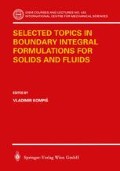Abstract
A boundary element formulation for 3D-elastostatics and 3D-elastodynamics is presented which avoids singular boundary integrals. The proposed method is based on a generalized variational principle. A weighted superposition of static fundamental solutions is used for the field approximation in the domain, whereas the displacement and stress field on the boundary are interpolated by well-known polynomial shape functions. By separating time-and space-dependence a symmetric equation of motion is derived with time-independent mass and stiffness matrix. The domain integral over inertia terms, leading to the mass matrix, is analytically transformed to the boundary. Thus, a boundary only formulation is derived. Comparing numerical results with analytical solutions clearly shows that the obtained system of equations is well-suited for dynamic problems.
Support by the Deutsche Forschungsgemeinschaft DFG of the Graduate Collegium ‘Modelling and dis- cretization methods for continua and fluids’ at the University of Stuttgart is gratefully acknowledged.
Access this chapter
Tax calculation will be finalised at checkout
Purchases are for personal use only
Preview
Unable to display preview. Download preview PDF.
References
Bathe, K. J., and Wilson, E. L. (1976). Numerical Methods in Finite Element Analysis. Englwood Cliffs: Prentice-Hall, Inc.
Davi, G. (1992). A hybrid displacement variational formulation of bem for elastostatics. Engineering Analysis with Boundary Elements 10: 219–224.
DeFigueiredo, T. G. B., and Brebbia, C. A. (1989). A new hybrid displacement variational formulation of bem for elastostatics. volume 1, 47–57. Springer-Verlag.
Dumont, N. A. (1999). An assessment of the spectral properties of the matrices obtained in the boundary element methods. In Proc. 15th Brazilian Congress of Mechanical Engineering.
Gaul, L., and Fiedler, C. (1996). Fundamentals of the dynamic hybrid boundary element method. Zeitschrift für angewandte Mathematik und Mechanik 74 (4): 539–542.
Gaul, L., and Fiedler, C. (1997). Methode der Randelemente in Statik und Dynamik. Braunschweig: Vieweg Verlag.
Gaul, L., and Wenzel, W. (1998). A symmetric boundary element formulation for time-domain analyses of acoustic problems. In Proc. of Euro Noise 98, volume 1, 123–128.
Gaul, L., Wagner, M., and Wenzel, M. (2000). Hybrid boundary element methods in frequency and time domain. In von Estorff, O., ed., Boundary Elements in Acoustics, Advances and Applications, 121–164. Southampton: WIT Press.
Graff, K. F. (1975). Wave Motion in Elastic Solids. London: Oxford University Press.
Moser, F. (2001). Nicht-singuläre räumliche Randelementformulierung der Elastodynamik. Bericht aus dem Institut A für Mechanik (to be published), Universität Stuttgart.
Nardini, D., and Brebbia, C. A. (1985). Boundary element formulations of mass matrices for dynamic analysis. Topics in boundary element research Vol. 2: Time-dependent and vibration problems:191208.
Partridge, P. W., Brebbia, C. A., and Wrobel, L. C. (1992). The Dual Reciprocity Boundary Element Method. Southampton: Computational Mechanics Publications.
Washizu, K. (1975). Variational methods in elasticity and plasticity. 2. Aufl. Oxford: Pergamon Press Ldt.
Author information
Authors and Affiliations
Editor information
Editors and Affiliations
Rights and permissions
Copyright information
© 2002 Springer-Verlag Wien
About this chapter
Cite this chapter
Gaul, L., Moser, F. (2002). A Hybrid Boundary Element Approach without Singular Boundary Integrals. In: Kompiš, V. (eds) Selected Topics in Boundary Integral Formulations for Solids and Fluids. International Centre for Mechanical Sciences, vol 433. Springer, Vienna. https://doi.org/10.1007/978-3-7091-2548-9_10
Download citation
DOI: https://doi.org/10.1007/978-3-7091-2548-9_10
Publisher Name: Springer, Vienna
Print ISBN: 978-3-211-83693-4
Online ISBN: 978-3-7091-2548-9
eBook Packages: Springer Book Archive

